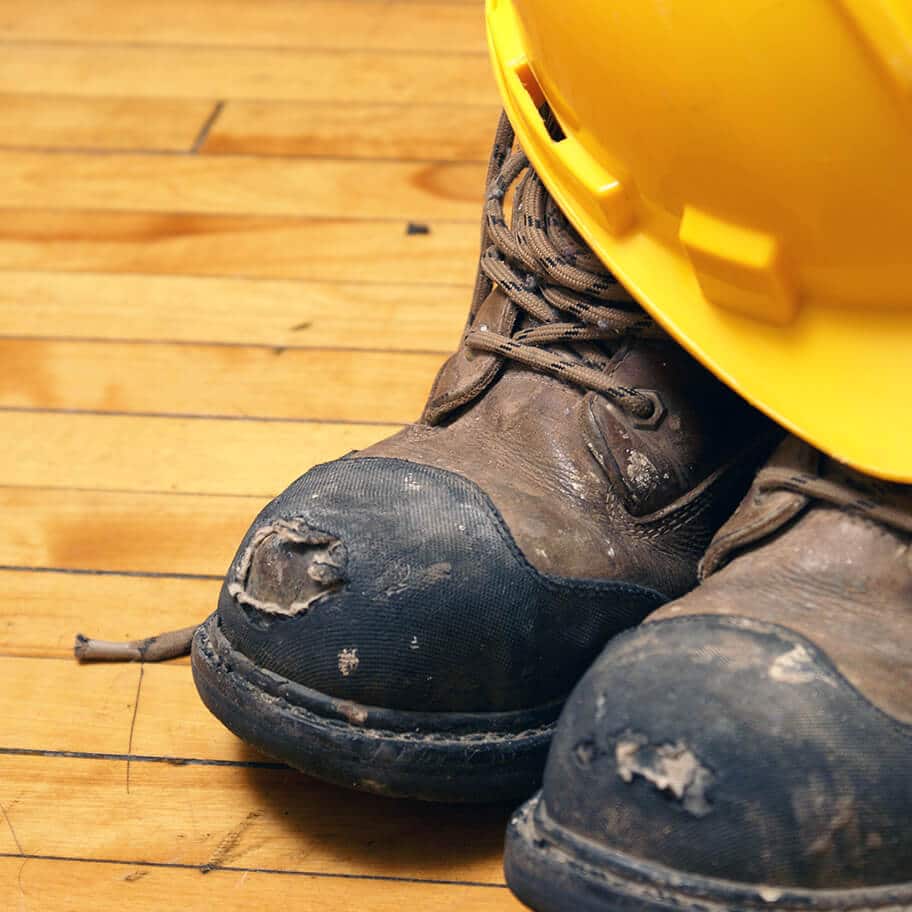Employer Responsibility to Provide PPE
It is up to your employer to supply this to you as they have a reasonable duty of care to their staff. Steel cap boots are classed as Personal Protective Equipment (PPE) which also includes clothing, footwear, glasses, hats, facial protection and gloves. The use of protective equipment in the workplace can greatly reduce the chances of an accident or injury occurring.
Liability
Defective protective equipment can also lead to workplace injuries, therefore it is important that this equipment is well maintained and repaired or replaced as needed. An employee should not have to use inadequate protective gear when carrying out their role.
Defective steel toe cap boots can cause long-term injuries which may leave the injured unable to work for a certain period of time. These boots are designed to prevent or minimise the chance of injuries being sustained by the wearer as they add a level of protection to the feet from falling objects or compression. They also help to protect against injuries from standing or walking on objects below the foot. A common cause of injuries is as a result of wear and tear of the boots over time.
Employer Duties
An employer has a duty of care to ensure that an employee’s health and safety is a priority while they are at work. This should be the number one priority in any industry. It is the employers’ responsibility to carry out frequent risk assessments as this will help to identify potential hazards. This will also make them aware of the protective equipment which may be necessary for their particular workplace. It is their responsibility to ensure that steel toe cap boots are provided to those who need them.
Employee Duties
The PPE that is required by employees should also be set out in the health and safety regulations of the company so that all employees are aware of this. If it is found that an employer has breached their duty of care and acted in a negligent manner, they will be found liable for the cause of any injuries sustained. Employees also have a responsibility to ensure that they wear any equipment that is provided to them by their employer as they may also be found liable due to contributory negligence.
In some cases, the manufacturer of the work boots may be found liable if they failed to provide a product which met the health and safety requirements. A common complaint would be defects in the material used when manufacturing the boots. If it is found that the materials used do not comply with regulations or are defective as a result of negligence on part of the manufacturer then the manufacturer will be found liable for any injuries sustained as a result. Warranty claims are commonly associated with this as there may have been an issue with the boots within the time of warranty and guarantee since the date of purchase.
Personal Protective Equipment (PPE) Regulations
There are certain regulations in place which provide for the health and safety of employees in the workplace. The first being the Safety, Health and Welfare at Work Regulations 2007. These regulations outline that protective equipment should be provided to employees in a hazardous environment. They also say that an assessment should be carried out to determine what equipment is needed and for how long it should be worn throughout the working day. It is also important that any equipment provided is maintained and kept in a good condition. It should then be replaced as soon as possible when this becomes necessary.
The European Communities PPE Regulations 1993 are in place to ensure that no PPE is placed on the market unless it complies with the health and safety standards and requirements. PPE is deemed to be satisfactory if it has the ‘CE Mark’. It is up to both the employer and employee to ensure that protective equipment, especially footwear, meets the standards in place so as to reduce the risk of injury if an accident were to happen.
Foot Injuries
Common foot injuries caused by defective steel toe cap boots include:
- Crushing Injuries
- Breaks and Fractures (Broken or fractures toes/bones in the foot)
- Amputations (loss of toes)
- Cuts and Lacerations
- Sprains and Strains
What to do after an accident at work*?
Following an accident at work, there are a number of steps you should follow:
-
Seek medical attention
Your health is your wealth and should be your first priority. Immediately after an accident at work, take a second to assess yourself to determine if you have any injuries and seek the relevant medical attention. If you have sustained a serious injury ensure that you contact an ambulance to attend the scene.
For minor injuries, you must remember that minor injuries where you ‘feel fine’ could progress to more serious injuries in the future. In this case it is always better to be safe than sorry and advisable that you go to your nearest accident and emergency (A&E) or local GP to be checked out.
-
Report the accident
It is critical to report the accident to your superior, i.e. a supervisor or manager on site. It doesn’t matter how small you think the accident may be. By law, accidents at work are required to be reported if the person is injured and can’t perform their daily work tasks for more than three days. Make sure to fill out an Accident Report Form. This can be used for reference in any medical examination and will also prevent any similar accidents from happening in the future.
-
Identify any witnesses
If possible, try to collect the contact details of anybody that witnessed your accident. This may be of use if you do decide to pursue a workplace accident claim. It is also useful to find out if there is any CCTV in the area where your accident happened.
-
Document the incident
It is important that you collect all the relevant information in connection with your accident:
- How the accident happened
- Details of any witnesses
- If there are any CCTV recordings of your accident
- Take pictures of where the accident happened and what caused your accident
-
Speak to a workplace accident solicitor
If you are considering moving forward with a workplace accident claim for any personal injuries sustained, it is advisable that you speak with a workplace accident claims solicitor as soon as possible. If you are proceeding with a claim, the first step will be submitting your claim to the Personal Injuries Assessment Board (PIAB) for assessment. A workplace accident solicitor can help you in preparing your application to the Personal Injuries Assessment Board (PIAB) and ensure that you follow the process in the correct format, meaning that you can move forward with your claim quickly without unnecessary delays.
It is important to remember to keep copies of any expenses that you have incurred as a result of the accident. It is also imperative to retain copies of medical reports or incident report forms where possible as you will need them when making a claim.

